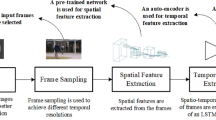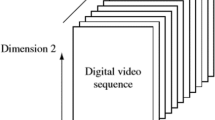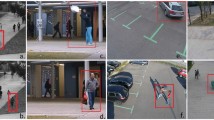Abstract
Nowadays, due to the increasing crime and theft around the world, surveillance security systems play an important role. On the other hand, the availability of video editing tools has made authenticity of video contents significant and urgent mission to use as strong evidence in the courts. Frame duplication with/without shuffling is a common form of video forgery to repeat or cover-up an event in a video’s scene. In this paper, we propose a robust method to detect inter-frame duplication forgery using a temporal average of each shot and statistical textural features. Duplicated shots containing frames that are reordered during the forgery process (frame shuffling), cannot be classified as tampered shots by the existing methods leading to an increase in false positives. To address this issue, we use a temporal average of each shot which found to be invariant with different orders. Our method is capable of detecting duplicate shots that do not have any tracing points (discontinuity points). Experimental results show that our method has achieved improved accuracy on frame duplication detection with lower computational time. Furthermore, it has successfully detected frame shuffling with high accuracy rates, even when the forged video has undergone post-processing operations such as Gaussian blurring, noise addition, brightness modification, and compression.
























Similar content being viewed by others
Notes
The pixel-wise difference has been calculated per color channel.
According to the proposed method, each frame has contained 3 channels (RGB) and TP has been computed for each channel as the average of points in the same positions of the same channel.
Lexicographical sorting is a generalization of the way words are alphabetically ordered based on the alphabetical order of their component letters. This generalization consists primarily in defining a total order over the sequences of elements of a finite totally ordered set, often called an alphabet.
References
Bakas J, Naskar R, Dixit R (2019) Detection and localization of inter-frame video forgeries based on inconsistency in correlation distribution between haralick coded frames. Multimed Tools Appl 78(4):4905–4935. https://doi.org/10.1007/s11042-018-6570-8
Baudry S (2012) Frame-accurate temporal registration for non-blind video watermarking. In: Proceedings of the on multimedia and security MM&Sec ’12. ACM, New York, pp 19–26, DOI https://doi.org/10.1145/2361407.2361411
Baudry S, Chupeau B, Lefébvre F (2009) A framework for video forensics based on local and temporal fingerprints. In: 2009 16th IEEE international conference on image processing (ICIP), pp 2889–2892. https://doi.org/10.1109/ICIP.2009.5413438
Bharati MH, Liu J, MacGregor JF (2004) Image texture analysis: methods and comparisons. Chemom Intell Lab Syst 72(1):57–71. https://doi.org/10.1016/j.chemolab.2004.02.005
Boreczky JS, Rowe LA (1996) Comparison of video shot boundary detection techniques. J Electron Imag 5(2):122–128–7. https://doi.org/10.1117/12.238675
Cuevas C, Yáñez EM, García N (2016) Labeled dataset for integral evaluation of moving object detection algorithms: Lasiesta. Comput Vis Image Understand 152(Supplement C):103–117. https://doi.org/10.1016/j.cviu.2016.08.005, http://www.gti.ssr.upm.es/data/lasiesta_database.html, [Online; accessed 08-May-2018]
Domnic S (2011) Video shot cut detection using least square approximation method. In: Computer networks and intelligent computing. Springer, pp 161–170
Dugad R, Ratakonda K, Ahuja N (1998) Robust video shot change detection. In: 1998 IEEE Second workshop on multimedia signal processing. IEEE, pp 376–381
Elaskily MA, Elnemr HA, Dessouky MM, Faragallah OS (2019) Two stages object recognition based copy-move forgery detection algorithm. Multimed Tools Appl 78(11):15353–15373. https://doi.org/10.1007/s11042-018-6891-7
Emam M, Han Q, Niu X (2016) Pcet based copy-move forgery detection in images under geometric transforms. Multimed Tools Appl 75(18):11513–11527. https://doi.org/10.1007/s11042-015-2872-2
Fadl SM, Semary NA (2017) Robust copy–move forgery revealing in digital images using polar coordinate system. Neurocomputing 265:57–65. https://doi.org/10.1016/j.neucom.2016.11.091
Fadl SM, Han Q, Li Q (2018) Authentication of surveillance videos: detecting frame duplication based on residual frame. J Forens Sci 63(4):1099–1109. https://doi.org/10.1111/1556-4029.13658
Fadl S, Han Q, Li Q (2019) Surveillance video authentication using universal image quality index of temporal average. In: Digital forensics and watermarking, IWDW. Springer International Publishing, Cham, pp 337–350, DOI https://doi.org/10.1007/978-3-030-11389-6_25
Haralick RM, Shanmugam K, Dinstein I (1973) Textural features for image classification. IEEE Trans Syst Man Cybern SMC-3(6):610–621. https://doi.org/10.1109/TSMC.1973.4309314
K S, Mehtre B (2018) Detection of inter-frame forgeries in digital videos. Forens Sci Int 289:86–206. https://doi.org/10.1016/j.forsciint.2018.04.056. http://www.sciencedirect.com/science/article/pii/S0379073818302809
Lee JC (2015) Copy-move image forgery detection based on gabor magnitude. J Vis Commun Image Represent 31(C):320–334. https://doi.org/10.1016/j.jvcir.2015.07.007
Li H, Luo W, Qiu X, Huang J (2017) Image forgery localization via integrating tampering possibility maps. IEEE Trans Inform Forens Secur 12 (5):1240–1252. https://doi.org/10.1109/TIFS.2017.2656823
Liao SY, Huang TQ (2013) Video copy-move forgery detection and localization based on tamura texture features. In: 2013 6th international congress on image and signal processing (CISP), vol 2, pp 864–868, DOI https://doi.org/10.1109/CISP.2013.6745286
Lienhart RW (1998) Comparison of automatic shot boundary detection algorithms. In: Storage and retrieval for image and video databases VII, vol 3656. International Society for Optics and Photonics, pp 290–302
Lin GS, Chang JF, Chuang CH (2011) Detecting frame duplication based on spatial and temporal analyses. In: 6th International conference on computer science education (ICCSE), pp 1396–1399. https://doi.org/10.1109/ICCSE.2011.6028891
Liu Y, Huang T (2017) Exposing video inter-frame forgery by Zernike opponent chromaticity moments and coarseness analysis. Multimed Syst 23(2):223–238. https://doi.org/10.1007/s00530-015-0478-1
Mahmood T, Mehmood Z, Shah M, Saba T (2018) A robust technique for copy-move forgery detection and localization in digital images via stationary wavelet and discrete cosine transform. J Vis Commun Image Represent 53:202–214. https://doi.org/10.1016/j.jvcir.2018.03.015
Nixon MS, Aguado AS (2012) Feature extraction & image processing for computer vision. Academic Press
Ouyang J, Liu Y, Liao M (2019) Robust copy-move forgery detection method using pyramid model and Zernike moments. Multimed Tools Appl 78(8):10207–10225. https://doi.org/10.1007/s11042-018-6605-1
Pun CM, Liu B, Yuan XC (2016) Multi-scale noise estimation for image splicing forgery detection. J Vis Commun Image Represent 38:195–206. https://doi.org/10.1016/j.jvcir.2016.03.005
Qadir G, Yahaya S, Ho A (2012) Surrey university library for forensic analysis (sulfa) of video content. IET Conference Proceedings, pp 121–121(1). http://sulfa.cs.surrey.ac.uk/index.php, [Online; accessed 08-May-2018]
Shi Y, Qi M, Yi Y, Zhang M, Kong J (2013) Object based dual watermarking for video authentication. Optik - Int J Light Electron Opt 124 (19):3827–3834. https://doi.org/10.1016/j.ijleo.2012.11.078
Singh VK, Pant P, Tripathi RC (2015) Detection of frame duplication type of forgery in digital video using sub-block based features. In: 7th International conference on digital forensics and cyber crime, ICDF2C. Springer, Seoul, pp 29–38, DOI https://doi.org/10.1007/978-3-319-25512-5_3
Sitara K, Mehtre B (2016) Digital video tampering detection: an overview of passive techniques. Digit Investig 18(Supplement C):8–22. https://doi.org/10.1016/j.diin.2016.06.003
Sohn H, Neve WD, Ro YM (2011) Privacy protection in video surveillance systems: analysis of subband-adaptive scrambling in jpeg xr. IEEE Trans Circ Syst Video Technol 21(2):170–177. https://doi.org/10.1109/TCSVT.2011.2106250. http://ivylab.kaist.ac.kr/demo/vs/dataset.htm, [Online; accessed 08-May-2018]
Ulutas G, Ustubioglu B, Ulutas M, Nabiyev V (2017) Frame duplication/mirroring detection method with binary features. IET Image Process 11 (5):333–342. https://doi.org/10.1049/iet-ipr.2016.0321
Ulutas G, Ustubioglu B, Ulutas M, Nabiyev VV (2018) Frame duplication detection based on bow model. Multimed Syst 24(5):549–567. https://doi.org/10.1007/s00530-017-0581-6
Wang W, Farid H (2007) Exposing digital forgeries in video by detecting duplication. In: Proceedings of the 9th workshop on multimedia & security. ACM, pp 35–42
Wang W, Jiang X, Wang S, Wan M, Sun T (2014) Identifying video forgery process using optical flow. In: 12th International workshop on digital forensics and watermarking, IWDW. Springer, Auckland, pp 244–257, DOI https://doi.org/10.1007/978-3-662-43886-2_18
Yang J, Huang T, Su L (2016) Using similarity analysis to detect frame duplication forgery in videos. Multimed Tools Appl 75(4):1793–1811. https://doi.org/10.1007/s11042-014-2374-7
Zabih R, Miller J, Mai K (1995) Feature-based algorithms for detecting and classifying scene breaks. Tech. rep., Cornell University
Zhang H, Kankanhalli A, Smoliar SW (1993) Automatic partitioning of full-motion video. Multimed Syst 1(1):10–28. https://doi.org/10.1007/BF01210504
Zhang W, Lin J, Chen X, Huang Q, Liu Y (2006) Video shot detection using hidden Markov models with complementary features. In: First International conference on innovative computing, information and control, 2006. ICICIC’06, vol 3. IEEE, pp 593–596
Zhang Q, Lu W, Weng J (2016) Joint image splicing detection in dct and contourlet transform domain. J Vis Commun Image Represent 40:449–458. https://doi.org/10.1016/j.jvcir.2016.07.013
Zhao DN, Wang RK, Lu ZM (2018) Inter-frame passive-blind forgery detection for video shot based on similarity analysis. Multimed Tools Appl 77(19):25389–25408. https://doi.org/10.1007/s11042-018-5791-1
Zheng L, Sun T, Shi YQ (2015) Inter-frame video forgery detection based on block-wise brightness variance descriptor. In: International workshop on digital forensics and watermarking, IWDW. Springer, Taipei, pp 18–30, DOI https://doi.org/10.1007/978-3-319-19321-2-2
Acknowledgments
This work was supported by the National Natural Science Foundation of China [grant numbers 61471141, 61361166006, 61301099]; Key Technology Program of Shenzhen, China, [grant number JSGG20160427185010977]; Basic Research Project of Shenzhen, China [grant number JCYJ20150513151706561].
Author information
Authors and Affiliations
Corresponding author
Additional information
Publisher’s note
Springer Nature remains neutral with regard to jurisdictional claims in published maps and institutional affiliations.
Rights and permissions
About this article
Cite this article
Fadl, S., Megahed, A., Han, Q. et al. Frame duplication and shuffling forgery detection technique in surveillance videos based on temporal average and gray level co-occurrence matrix. Multimed Tools Appl 79, 17619–17643 (2020). https://doi.org/10.1007/s11042-019-08603-z
Received:
Revised:
Accepted:
Published:
Issue Date:
DOI: https://doi.org/10.1007/s11042-019-08603-z




